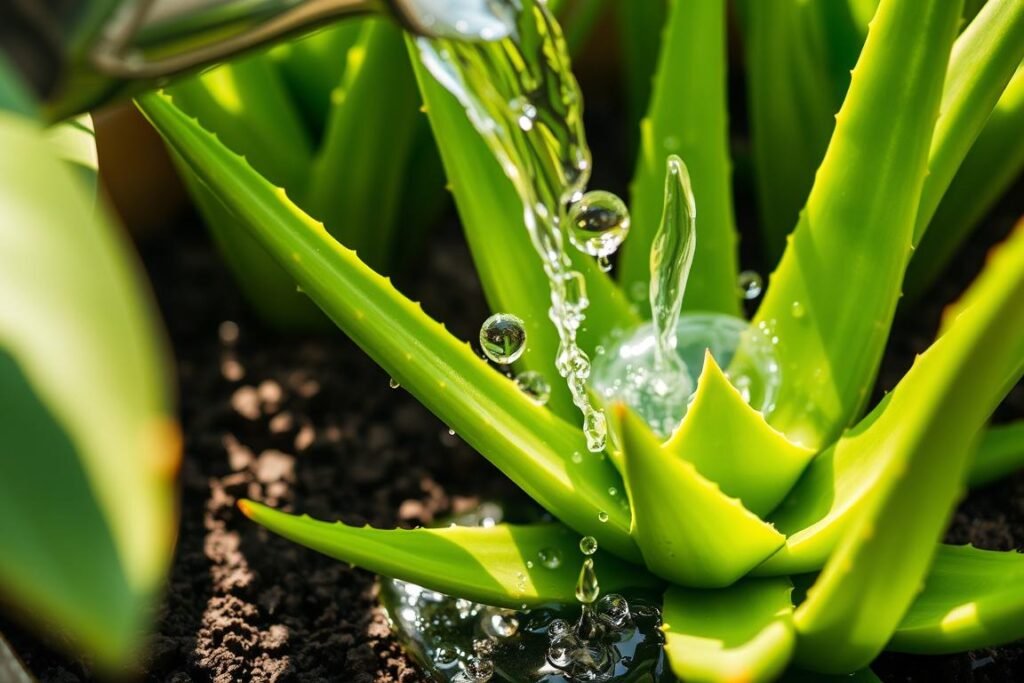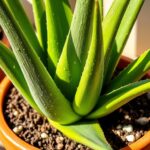I love aloe vera plants and feel sad when they get sick. These plants are known for being easy to care for. But, even the toughest aloe can get sick if we don’t take good care of it.
If your aloe’s leaves are hanging down, its color is off, or its texture is bad, don’t worry. You can make it healthy again with the right steps.

In this guide, we’ll look at how to tell if your aloe is sick and why. We’ll talk about the best pot, soil, watering, and light for it. I’ll share tips to help your aloe come back strong.
With a little time and care, your aloe will be beautiful again. It will be a great addition to your home.
Key Takeaways
- Aloe vera plants need the right care to stay healthy, like the right pot, soil, and water.
- Knowing the signs of sickness, like color changes and texture, helps find the problem.
- Checking and fixing the roots is key to saving a sick aloe.
- Aloe plants need bright, indirect light and should avoid very hot or cold temperatures.
- With the right steps, even a very sick aloe can get better and look great again.
Identifying Signs of a Struggling Aloe Plant
Watching your aloe plant closely is very important. Aloe plants show signs when they are not doing well. By looking at the color, texture, and look of the leaves, you can find and fix problems.
Common Visual Symptoms
One clear sign of trouble is the leaves. Too much water makes them yellow, brown, or swollen. Not enough water makes them puckered, shriveled, or see-through. Checking the leaves often helps spot problems early.
Understanding Color Changes
Color changes in aloe plants can mean different things. Leaves turning reddish-brown might mean sunburn. Spots or color changes could mean the plant needs more nutrients. Watching for these color changes helps you know what your plant needs.
Leaf Texture Indicators
The feel of the leaves can also tell you a lot. Mushy leaves mean too much water. Leaves that are thin and droopy might not have enough water. Wilting leaves and a dark, wet look can mean root rot, which is very serious.
Checking your aloe’s leaves and soil often is key. By watching for signs of trouble, you can fix problems fast and help your aloe plant do well.
| Symptom | Possible Cause |
|---|---|
| Yellowing, browning, or swollen leaves | Overwatering |
| Puckering, shriveling, or transparent leaves | Underwatering |
| Reddish-brown discoloration | Sunburn |
| Spots or discoloration | Nutrient deficiency |
| Mushy, soft leaves | Overwatering |
| Thin, drooping leaves | Underwatering |
| Wilting leaves, dark, watery appearance | Root rot |
Proper Container and Soil Requirements
To make a dying aloe vera plant healthy again, start with the right pot and soil. Pick a pot that’s 1-2 inches bigger than your aloe plant. This extra room helps the roots grow well.
Make sure the pot has holes for water to drain. Aloe plants don’t like wet roots, which can cause rot.
For the soil, choose a good desert potting mix or make your own. Mix sand, gravel or perlite, and regular potting soil in equal parts. This mix helps the soil drain well, keeping your aloe plant healthy.
Choosing the Right Pot Size
Aloe vera plants can grow big, up to 3 feet tall and 2 feet wide. Pick a pot that’s a bit bigger than your plant now. But don’t choose a pot that’s too big, or it might get too wet.
Essential Drainage Features
Drainage is key for aloe vera plants. Your pot should have holes in the bottom for water to drain. This keeps the roots dry, preventing rot and keeping your plant healthy.
Optimal Soil Mix Components
- Sand: Improves soil drainage and aeration
- Gravel or perlite: Enhances drainage and prevents compaction
- Potting soil: Provides essential nutrients for plant growth
Choosing the right pot and soil mix is important. It helps your aloe vera plant grow strong and healthy again.
“Proper container and soil selection are crucial for the overall health and revival of an aloe vera plant.”
Root System Assessment and Care
Fixing an underwatered aloe starts with checking its roots. Fixing an underwatered aloe means looking closely at the roots. This helps find problems and fix them.
Good aloe roots are thick and firm. They are usually tan, orange, or yellow. Bad roots are brown, black, or soft. Cutting off these roots with clean tools helps the plant get better.
If not many good roots are left, focus on the top part of the aloe plant care. Cut off any bad leaves or shoots. This keeps the plant stable and healthy.
For very sick aloe plants, start new ones from healthy parts. Cut off healthy parts and plant them in new soil. When these new plants grow strong roots, move them to their own pots.
Always put the aloe in new, draining soil after checking and pruning. This helps the plant grow well again.

| Aloe Root Characteristics | Healthy Roots | Unhealthy Roots |
|---|---|---|
| Appearance | Thick, somewhat rigid, tan/orange/yellow in color | Brown, black, or soft |
| Condition | Robust and vibrant | Decaying or damaged |
| Function | Actively absorbing water and nutrients | Unable to support the plant’s needs |
Watering Techniques for Recovery
Watering right is key to saving a sick aloe vera plant. You need to find the perfect balance. Too much or too little water can harm the plant.
Knowing when to water and adjusting for the seasons helps. This way, your aloe plant can start to grow strong again.
Proper Watering Schedule
Indoor aloe plants need water every 3-4 weeks. Make sure the top third of the soil is dry before watering again. Outdoor aloe plants might need water every 2 weeks.
Seasonal Adjustments
Change your watering as the seasons change. Water less in fall and winter when the plant grows slower. In spring and summer, water more often to keep the soil right.
Signs of Over and Under-Watering
- Overwatering signs: Yellow, brown, or swollen leaves, and waterlogged soil with bad-smelling roots.
- Underwatering signs: Leaves that pucker or shrink, and the plant looks wilted.
Watch for these signs to adjust your watering. This helps your aloe plant recover and stay healthy. Right watering is essential for a dying aloe vera plant.

Light and Temperature Requirements
For a thriving aloe plant, the right light and temperature are key. Aloe vera plants love bright, indirect sunlight. They do best near south or west-facing windows, getting at least 6 hours of sunlight a day.
But, don’t put them right on the windowsill. This can cause sunburn. East-facing windows are okay too, as long as they get enough sunlight.
Aloe vera plants like temperatures between 55 to 80°F (13 to 27°C). Most homes and apartments are perfect for them. To keep them healthy, avoid cold drafts and freezing temperatures.
If your aloe plant’s leaves turn brown or reddish, it might be sunburned. Move it to a spot with less direct sunlight slowly. The right light and temperature help your aloe plant stay healthy and green.
FAQ
What are the common signs of a struggling aloe vera plant?
Signs include droopy leaves and color changes. Texture changes also show trouble. These can mean too much water, not enough, bad light, or pests.
How do I choose the right container and soil for my aloe plant?
Pick a container 1-2 inches bigger than your plant. Make sure it has holes for water to drain. Use desert potting mix or a mix of sand, gravel, and soil for good drainage.
How do I assess and care for my aloe plant’s root system?
Carefully take the aloe out of its pot to see the roots. Healthy roots are thick and tan or yellow. Cut off any brown or soft roots with clean pruners.
Put the aloe in new soil after checking and trimming the roots.
What is the proper watering schedule for an aloe vera plant?
Water indoor aloes every 3-4 weeks and outdoor ones every 2 weeks. Adjust based on the season. Water until it drains well, then let the top soil dry before watering again.
What are the ideal light and temperature conditions for an aloe vera plant?
Aloes love bright, indirect light. Place them near windows that face south or west but not too close. Keep the temperature steady and avoid sudden changes.
If leaves turn brown or red, it might be too sunny. Move it to a spot with less sun.






